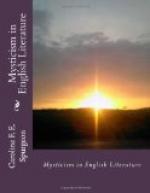Whatever may be the source or reason, it is clear that at the end of the eighteenth century we begin to find a mystical tinge of thought in several thinkers and writers, such as Burke, Coleridge, and Thomas Erskine of Linlathen. This increases in the early nineteenth century, strengthened by the influence, direct and indirect, of Boehme, Swedenborg, and the German transcendental philosophers and this mystical spirit is very marked in Carlyle, and, as we shall see, in most of the greatest nineteenth-century poets.
In addition to those writers which are here dealt with in detail, there is much of the mystic spirit in others of the same period, to name a few only, George Meredith, “Fiona Macleod,” Christina Rossetti, and Mrs Browning; while to-day writers like “A. E.,” W. B. Yeats, and Evelyn Underhill are carrying on the mystic tradition.
Chapter II
Love and Beauty Mystics
In studying the mysticism of the English writers, and more especially of the poets, one is at once struck by the diversity of approach leading to unity of end.
“There are,” says Plotinus, “different roads by which this end [apprehension of the Infinite] may be reached. The love of beauty, which exalts the poet; that devotion to the One and that ascent of science which makes the ambition of the philosopher; and that love and those prayers by which some devout and ardent soul tends in its moral purity towards perfection. These are the great highways conducting to that height above the actual and the particular, where we stand in the immediate presence of the Infinite, who shines out as from the deeps of the soul.”—Letter to Flaccus.
We have grouped together our English writers who are mystical in thought, according to the five main pathways by which they have seen the Vision: Love, Beauty, Nature, Wisdom, or Devotion. Even within these groups, the method of approach, the interpretation or application of the Idea, often differs very greatly. For instance, Shelley and Browning may both be called love-mystics; that is, they look upon love as the solution of the mystery of life, as the link between God and man. To Shelley this was a glorious intuition, which reached him through his imagination, whereas the life of man as he saw it roused in him little but mad indignation, wild revolt, and passionate protest. To Browning this was knowledge—knowledge borne in upon him just because of human life as he saw it, which to him was a clear proof of the great destiny of the race. He would have agreed with Patmore that “you can see the disc of Divinity quite clearly through the smoked glass of humanity, but no otherwise.” He found “harmony in immortal souls, spite of the muddy vesture of decay.”




